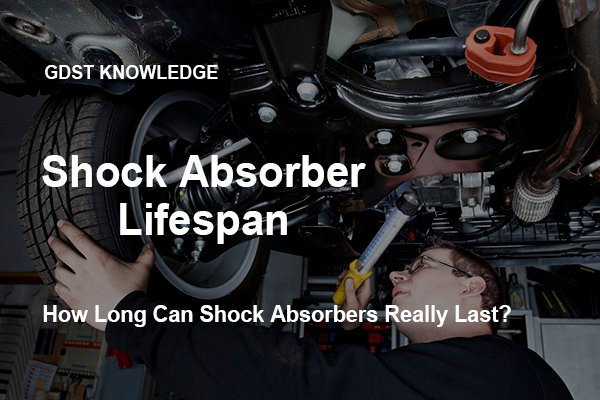Have you ever wondered how long your shock absorber really last? It’s a common question for distributors and wholesalers in the automotive industry since the life of shock absorbers can significantly influence vehicle performance and safety.
Shock absorbers, crucial for vehicle stability and comfort, typically last between 50,000 to 100,000 miles. However, factors like driving habits, road conditions, and vehicle maintenance can extend or shorten this range. To ensure optimal performance, these components may need replacement within four to five years, particularly in harsh driving environments.
But what influences their durability, and how can you tell it’s time for a change?
How Often Should You Replace Shock Absorbers?

Shock absorbers are an important part of your car’s suspension system. They help to give you a smooth ride and keep your tires on the road, which improves control and safety. How often you should replace your shock absorbers depends on many factors, such as the type of vehicle you drive, your driving style, and the conditions you drive in. But there are some general guidelines and signs that you may need to replace them.
General Guidelines
- Mileage: Normally, check your shock absorbers every 50,000 miles. But, please refer to the car manual for the accurate mileage.
- Driving Conditions: If you often drive on bumpy roads or carry heavy loads, your shock absorbers may wear out faster and need more frequent replacements.
- Performance Indicators: Pay attention to the car handling. Any change in the performance may mean that your shock absorbers need to be checked.
What Are the Symptoms of Worn Shock Absorbers?

Worn shock absorbers can affect the handling and safety of your vehicle. Here are some common symptoms of worn shock absorbers:
- Rough Ride: The most obvious sign is a rough ride. If the shocks are worn, they can’t absorb the bumps and jolts of the road effectively.
- Braking Problems: Worn shocks can increase the stopping distance of your vehicle. You might notice that the car dips forward excessively when braking.
- Swerving or Nose Diving: The car may sway or lean excessively when turning or in windy conditions. During sudden stops, the front end of the vehicle might dip down more than usual.
- Uneven Tire Wear: Worn shocks can cause uneven tire wear because the tires don’t maintain consistent contact with the road.
- Visible Damage or Leaks: If the shock absorbers are physically damaged, leaking fluid, or showing signs of excessive wear, they probably need to be replaced.
- Steering Issues: Difficulty steering or controlling the vehicle, especially at higher speeds, can be a symptom of worn shocks.
- Loud Noises: Knocking or banging sounds from the vehicle’s suspension can be a sign that the shock absorbers are failing.
The Lifespan of Shocks: What Factors Play a Role?

Several factors can affect the lifespan of shock absorbers, including:
- Driving conditions: If you regularly drive on rough, uneven, or off-road surfaces, your shock absorbers may wear out more quickly than if you stick to smooth, paved roads.
- Mileage: Generally, the more miles you drive, the more wear and tear your shock absorbers will experience.
- Vehicle load: If you frequently carry heavy loads or tow trailers, the extra stress on your shock absorbers can cause them to deteriorate faster.
- Driving style: Aggressive driving, such as rapid acceleration, hard braking, and fast cornering, can put extra strain on your shock absorbers and reduce their lifespan.
- Maintenance: If you neglect regular vehicle maintenance, such as failing to replace worn suspension components, your shock absorbers may wear out more quickly.
- Quality of shock absorbers: Higher-quality shock absorbers usually last longer than lower-quality ones, because they’re designed to withstand more abuse and have better durability.
- Climate and environment: Exposure to extreme temperatures, salt (in coastal areas or where roads are salted in winter), and moisture can corrode and damage your shock absorbers over time.
- Accidents and damage: Any direct damage to your shock absorbers from accidents or impacts (like hitting a curb or pothole) can reduce their effectiveness and lifespan.
Will Replacing Shocks Improve Ride Quality?

Replacing shocks can significantly improve ride quality. When you replace old or worn-out shocks with new ones, you can expect:
- Improved Ride Comfort: New shock absorbers can effectively reduce the jarring and vibration from driving on uneven surfaces, leading to a smoother ride.
- Enhanced Stability: Good shock absorbers can keep the tires in contact with the road, improving vehicle stability, especially at higher speeds or in windy conditions.
- Better Handling: Upgraded shock absorbers can effectively improve the vehicle’s response to steering inputs, enhancing handling and reducing body roll during turns.
- Reduced Wear on Other Components: Properly functioning shock absorbers can effectively reduce the strain on other suspension parts, potentially extending the life of these components.
Maintenance Tips for Extending Shock Absorber Life

To extend the life of your shock absorbers, consider the following maintenance tips:
- Regular Inspection: Regularly check your shock absorber for any sign of wear and tear, such as oil leakage, dent, or damage. Early detection of problems can avoid more serious damage later.
- Keep Them Clean: Dirt and debris can accumulate on the shock absorber, causing corrosion and wear. Please clean it with a soft cloth and a suitable cleaner to remove the dirt and prevent the build-up.
- Drive Carefully: Your driving habit will affect the life of the shock absorber directly. Please try to avoid potholes and rough roads as possible as you can. Gentle driving can reduce the stress and strain on the shock.
- Check for Leaks: Any oil leakage on the shock absorber means that it needs repair or replacement. The leakage will cause a loss of effectiveness and faster wear.
- Ensure Proper Alignment: Regularly check your vehicle’s wheel alignment. The improper alignment will cause uneven wear on the shock absorber and other suspension parts.
- Replace in Pairs: When one shock absorber needs to be replaced, it’s better to replace them in pairs (both front or both rear) to keep the balanced handling and stability.
- Use Quality Parts: When you replace the shock absorber, please choose the high-quality parts suitable for your vehicle’s make and model. The quality parts may cost more, but it can save money and improve safety.
- Regular Maintenance Checks: Please incorporate the check of shock absorber into your vehicle’s regular maintenance. It can be inspected by professional people and find the potential problem in advance.






